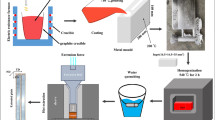Abstract
Microwave processing offers multiple advantages over conventional methods, such as shorter processing time. In the present study, Sn-0.7Cu alloy was melted using microwave energy at 900 W and 2.45 GHz. The alloy was then directionally solidified under different solidification conditions and while using mold materials. Influences of microwave exposure time, solidification conditions, and mold materials were investigated in terms of microstructure development, elemental distribution, phase formation, and mechanical properties of the casts. Results showed formation of a Sn-rich phase (primary phase) and Cu-rich phase (eutectic phase) consisting of Cu6Sn5 and Cu3Sn intermetallic compounds (IMCs). Graphite mold produced finer IMCs compared to alumina mold due to higher conductivity. A microstructure gradient was observed, while microwave irradiation was provided during solidification. The maximum ultimate tensile strength and hardness were found to be 44.69 ± 6.62 MPa and 11.53 ± 0.43 HV, corresponding to the graphite mold under higher heat extraction condition. Comparatively, elongation of the cast material decreased with increasing heat removal from the mold. The XRD analyses confirmed the presence of the Sn-rich phase and the intermetallic compounds Cu6Sn5 and Cu3Sn.















Similar content being viewed by others
Data Availability
No data were used for the research described in the article.
References
T. Ventura, S. Terzi, M. Rappaz, and A.K. Dahle, Effects of Solidification Kinetics on Microstructure Formation in Binary Sn-Cu Solder Alloys, Acta Mater., 2011, 59(4), p 1651–1658. https://doi.org/10.1016/j.actamat.2010.11.032
X. Hu, Y. Li, Y. Liu, and Z. Min, Developments of High Strength Bi-Containing Sn0.7Cu Lead-Free Solder Alloys Prepared by Directional Solidification, J. Alloys Compd., 2015, 625, p 241–250. https://doi.org/10.1016/j.jallcom.2014.10.205
X. Hu, W. Chen, and B. Wu, Microstructure and Tensile Properties of Sn-1Cu Lead-Free Solder alloy Produced by Directional Solidification, Mater. Sci. Eng. A, 2012, 556, p 816–823. https://doi.org/10.1016/J.MSEA.2012.07.073
A.A. El-Daly and A.E. Hammad, Development of High Strength Sn-0.7Cu Solders with the Addition of Small Amount of Ag and in, J. Alloys Compd., 2011, 509(34), p 8554–8560. https://doi.org/10.1016/j.jallcom.2011.05.119
X. Hu, K. Li, and Z. Min, Microstructure Evolution and Mechanical Properties of Sn0.7Cu0.7Bi Lead-Free Solders Produced by Directional Solidification, J. Alloys Compd., 2013, 566, p 239–245. https://doi.org/10.1016/j.jallcom.2013.03.034
A. Mondal, D. Agrawal, and A. Upadhyaya, Microwave Sintering of Refractory Metals/Alloys: W, Mo, Re, W-Cu, W-Ni-Cu and W-Ni-Fe Alloys, J. Microw. Power Electromagn. Energy, 2010, 44(1), p 28–44. https://doi.org/10.1080/08327823.2010.11689768
S.M. Lingappa, M.S. Srinath, and H.J. Amarendra, Melting of Bulk Non-ferrous Metallic Materials by Microwave Hybrid heating (MHH) and Conventional Heating: a Comparative Study on Energy Consumption, J. Brazilian Soc. Mech. Sci. Eng., 2018, 40(1), p 1–11. https://doi.org/10.1007/s40430-017-0921-7
C. Singhal, Q. Murtaza, and Parvej, Microwave Sintering of Advanced Composites Materials: A Review, Mater. Today Proc., 2018, 5(11), p 24287–24298. https://doi.org/10.1016/j.matpr.2018.10.224
M. Gupta, E.W.W. Leong, and W.L. Wong, Microwaves and metals, Asia: John Wiley and Sons, 2007.
D. Gamit, R.R. Mishra, and A.K. Sharma, Joining of Mild Steel Pipes using Microwave Hybrid Heating at 2.45 GHz and Joint Characterization, J. Manuf. Process., 2017, 27, p 158–168. https://doi.org/10.1016/j.jmapro.2017.04.028
K. Rödiger, K. Dreyer, T. Gerdes, and M. Willert-Porada, Microwave Sintering of Hardmetals, Int. J. Refract. Met. Hard Mater., 1998, 16(4–6), p 409–416. https://doi.org/10.1016/S0263-4368(98)00050-X
T. Gerdes, M. Willert-Porada, and K. Rödiger, Microwave Sintering of Tungsten Carbide Cobalt Hardmetals, MRS Online Proceed. Librar. OPL, 1996, 430, p 45–50.
N.K. Bhoi, H. Singh, and S. Pratap, Microwave Material Processing: a Clean, Green, and Sustainable Approach, Sustainable Engineering Products And Manufacturing Technologies. 2019, Academic Press. p 3–23.
T. Gerdes and M. Whxert-Porada, Microwave Sintering of Metal-Ceramic and Ceramic-Ceramic Composites, MRS Online Proceed. Libr. OPL., 1994, 347, p 531.
S. Chandrasekaran, T. Basak, and S. Ramanathan, Experimental and Theoretical Investigation on Microwave Melting of Metals, J. Mater. Process. Technol., 2011, 211(3), p 482–487. https://doi.org/10.1016/j.jmatprotec.2010.11.001
R.R. Mishra and A.K. Sharma, A Review of Research Trends in Microwave Processing of Metal-Based Materials and Opportunities in Microwave Metal Casting, Crit. Rev. Solid State Mater. Sci., 2016 https://doi.org/10.1080/10408436.2016.1142421
M.M. Franke, R.M. Hilbinger, A. Lohmüller, and R.F. Singer, The Effect of Liquid Metal Cooling on Thermal Gradients in Directional Solidification of Superalloys: Thermal Analysis, J. Mater. Process. Technol., 2013, 213(12), p 2081–2088. https://doi.org/10.1016/j.jmatprotec.2013.06.001
D. Szeliga, K. Kubiak, M. Motyka, and J. Sieniawski, Directional Solidification of Ni-Based Superalloy Castings: Thermal Analysis, Vacuum, 2016, 131, p 327–342. https://doi.org/10.1016/j.vacuum.2016.07.009
S. Hu, A. Gagnoud, Y. Fautrelle, R. Moreau, and X. Li, Fabrication of Aluminum Alloy Functionally Graded Material using Directional Solidification Under an Axial Static Magnetic Field, Sci. Rep., 2018, 8(1), p 1–13. https://doi.org/10.1038/s41598-018-26297-5
D. Du et al., In-situ Fabrication of Graded Material with the Application of a Horizontal Magnetic Field During Directional Solidification, Mater Charact, 2018, 141(March), p 423–432. https://doi.org/10.1016/j.matchar.2018.05.007
W. Yang, Y. Ding, M. Liao, and F. Wang, Effect of trace Ge on Interfacial Reaction and Shear Strength of Sn-0.7Cu Solder Joints during Isothermal Aging and Thermal Cycling, J. Mater. Sci. Mater. Electron., 2022, 33(21), p 17137–17151. https://doi.org/10.1007/s10854-022-08589-9
Acknowledgments
The authors gratefully acknowledge the Ministry of Education, Govt. of India, for providing fellowship during the Doctor of Philosophy (Ph.D.) program at Indian Institute of Technology Roorkee, Roorkee (India).
Author information
Authors and Affiliations
Corresponding author
Additional information
Publisher's Note
Springer Nature remains neutral with regard to jurisdictional claims in published maps and institutional affiliations.
Rights and permissions
Springer Nature or its licensor (e.g. a society or other partner) holds exclusive rights to this article under a publishing agreement with the author(s) or other rightsholder(s); author self-archiving of the accepted manuscript version of this article is solely governed by the terms of such publishing agreement and applicable law.
About this article
Cite this article
Parvej, Sharma, A.K. Effect of Mold Material and Solidification Conditions on Microstructural and Mechanical Properties of Directionally Solidified Sn-0.7Cu Alloy Developed Using Microwave Energy. J. of Materi Eng and Perform (2024). https://doi.org/10.1007/s11665-024-09732-9
Received:
Revised:
Accepted:
Published:
DOI: https://doi.org/10.1007/s11665-024-09732-9




